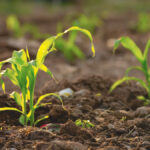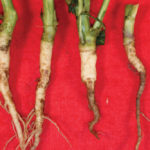Some say life success is about being in the right place at the right time. These are part of the guiding principle behind 4R nutrient stewardship, which farmers know well. Kelly Turkington, an AAFC pathology research scientist based in Lacombe, Alta., said the same principles can be applied to disease management. Speaking at the Farm […] Read more

The 4Rs of disease management
How to get the most out of your disease management tools

Crop disease experts take stock of 2020
Your provincial roundup of pulse and soybean diseases, what to watch for this year and emerging threats
From east to west, pulse and soybean growers face disease challenges, and last year was no different. For example, producers from all three provinces struggled with aphanomyces root rot in peas and lentils, Manitoba’s soybean farmers were warned of increased cases of soybean cyst nematode (plants are more susceptible to root rot and seedling disease […] Read more

Soil health management on Harvest Moon and NRG farms
Alberta and Saskatchewan producers discuss soil care
Since an unexpected disaster in 2017, in many respects, Alberta farmer Andy Kirschenman has had to start over. In October of that year, a massive fire ripped through Harvest Moon Farm. The Kirschenmans lost their house, a shed, a combine, quite a bit of equipment and most of the trees in the shelterbelt. But the […] Read more

Take a closer look at your soil assessment
Make sure these important soil health indicators are evaluated
Soil is a complex mixture of organic matter, minerals and countless organisms both alive and dead. To understand whether or not soil is healthy, all of its interconnected properties — physical, chemical and biological — must be evaluated. Through their interconnectivity, these three properties play a crucial role in soil health and affect key parameters […] Read more

How to manage sclerotinia stem rot in canola
Disease risk comes down to moisture
Sclerotinia stem rot is one of the most destructive diseases in canola. The fungus can cause up to 50 per cent yield loss. From year to year, region to region, and field to field, occurrence and severity are extremely variable. Foliar fungicides remain the main source of control. Canola Council of Canada agronomy director, Clint […] Read more

Verticillium stripe should be on your radar for 2020 and beyond
Three things you need to know about the disease
When Verticillium longisporum-infected canola was first discovered in Manitoba in 2014, it was quickly followed by countrywide soil surveys conducted by the Canadian Food Inspection Agency in 2015. Those surveys revealed V. longisporum populations in British Columbia and every province eastward as far as, and including, Quebec. And while it hasn’t reached the point where […] Read more

Steps to prevent and mitigate clubroot in your fields
Your guide to identification, risk reduction and disease control
Clubroot is a serious soil-borne disease. If conditions are right, it can cause up to 100 per cent yield loss in canola. And while yield loss can be low when conditions aren’t favourable, the pathogen is hardy and easily overwinters in the tough Canadian climate. Come spring, resting spores not only germinate where they overwintered, […] Read more

How to identify and prevent root rots in canola
If you’re not scouting for root rots, that doesn’t mean they’re not there
Survey data from Western Canada’s provincial agriculture departments don’t have really good numbers when it comes to root rots. The difficulty is not many growers are scouting for them, but that doesn’t mean they aren’t there. The pathogens that cause root rot can impact yield severely, especially if infection occurs early in the season. The […] Read more

Blackleg best management practices to keep disease levels low
Is blackleg increasing in your fields? Use BMPs to keep the disease at bay
For the longest time, yield loss due to blackleg has been significantly reduced through the use of disease-resistant canola varieties. However, those genetics were first introduced nearly 20 years ago and are now starting to be overcome. For a disease that has mostly been ignored by farmers, this means there is a need to reintroduce […] Read more

Oat diseases that affect your crop and what to do about them
Don’t let crown rust rob your yield
Following the announcement of plans to build a new oat mill in Manitoba last October, growers may be considering adding oats to the rotation. They’re a good cold-weather crop, prices have been decent and demand has been stable. Those adding oats to the rotation should be aware of the major diseases that affect both yield […] Read more


